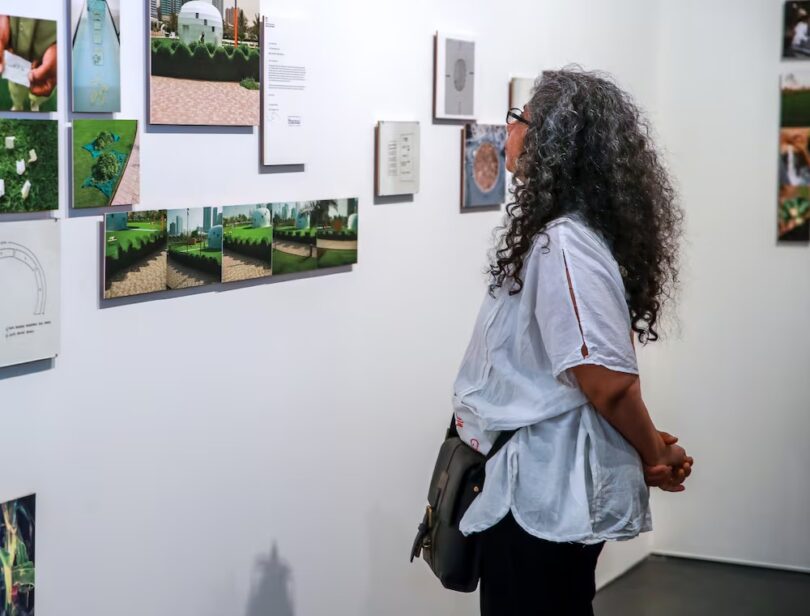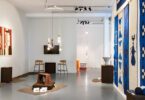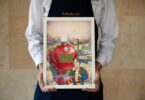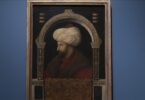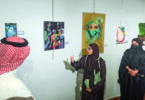Razmig Bedirian
The cities of the UAE are Vikram Divecha’s studio – its where the artist draws the resources that form and inform his artworks.
From broken concrete walls and structural columns to thermoplastic paints and interlock designs, Divecha relies on the core materials of cities to explore their socio-political structures. His examinations are rarely, if ever, a solitary endeavour. The artist, who has been living in Dubai for the past decade, often seeks out unlikely collaborations for his artworks, from random passers-by to municipal workers and gardeners. And in the end, it is often in everyday sites where the work is exhibited, encouraging viewers to consider the unseen social dynamics within.
Divecha’s artistic methodology is peculiar and difficult to confine into one mode. The idea of what he calls “found processes” is at the foundation of his method. In it, he ingrains himself into an urban environment, observing and interacting with individuals before determining the subject, form and execution of a given work.
The artist’s process branches out in all sorts of thought-provoking ways, and the breadth of his practice is on display in the artist’s first survey exhibition.
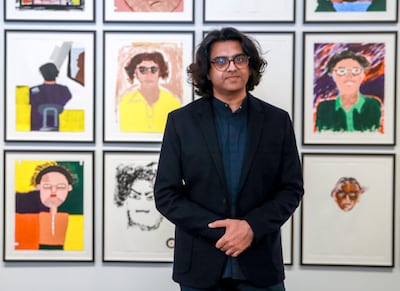
Running at Jameel Arts Centre until June 16, Short Circuits presents a range of works that Divecha has produced in the past decade. It is an impressive and assorted medley of ideas – the artworks range from sculptural works that take on the concept of shared experience to poetic video works that explore migrant experiences.
“The city is essentially the material I want to work with,” Divecha says. “It’s only recently that I’ve [come to] have a studio. But for the last decade, I didn’t have a proper studio in the UAE. In that process, I developed an approach where I was trying to align myself with processes, align myself with different industries in the UAE, and find ways to work with what’s available.”
What’s available, he says, are sites from which projects can emerge and individuals with unique skill sets who can help him bring an idea to form. In a way, it is the unexpected that drives Divecha’s work and from which the exhibition’s title springs.
“Short Circuits is basically when two points within a grid, that are not supposed to meet, meet,” he says. “And what potential exists when these two meet. My intention as an artist is to be a catalyst between these unexpected nodes in the circuit of the city. There’s some joy in that. And some playfulness in that which keeps me going.”
The first artwork in Short Circuits introduces Divecha’s process effectively. The work comprises a wall covered in dozens of portraits of the artist, each of which has been uniquely executed. Portrait Sessions is the result of a process between July and October 2016, when Divecha reached out to people living in the UAE, offering them Dh150 to paint a portrait of him.
There were two conditions. The first necessitated that those involved in the project could not be professional painters. The other stipulation is that participants could work on a portrait for however much time Dh150 would buy based on their professional wage.
The results, as expected, were multivariate. Some drew Divecha in scrawled, hurried forms. Others penciled his face with meticulous details or opted for a more colourful, but minimal depiction. Some drew his hair with a tempestuous flair, others focused on his square glasses. Backgrounds were left plain, had nightmarish scribbles, or featured serene plain colours. One simply and cheekily wrote: “This is a portrait of Vikram Divecha”.
However, transcending the aesthetic, Portrait Sessions aims to tackle the value system within the art world. The portraits, all of which are uncredited, bring up questions of how much an artwork is worth, whether it was based on the time or skill involved.

Gardeners’ Sketchbooks, meanwhile, is a collection of sketches produced by Sharjah’s municipal gardeners in 2017. The sketchbooks came about as Divecha prompted the gardeners to imagine how they would design the hedges of Al Majaz Waterfront. It was a move to bring the individuality of the gardeners to a landscape they are so intimately involved with maintaining yet have no creative agency over.
“I’ve known these gardeners since 2014,” Divecha says, adding that he had collaborated with them on several projects over the past decade. The sketchbooks, among the other works, he says, underscore their role as “stakeholders in these works in the gallery”.
“When they first met me, they couldn’t understand what I was doing in a public park,” he says. “They asked if I was an engineer or in landscaping. I’d say no I’m an artist and that I like working in a collaborative way. I spent a lot of time just unknowingly investing time in doing these little drawing workshops.”
The gardeners also collaborated with the artist for Beej in 2017. A project conceived for Sharjah Biennial 13, Beej – which translates from Urdu to seeds – revolved around a plot of land within a roundabout in Al Naba’ah, Sharjah, where farmers were invited to plant seeds and tend to their crops. Like Gardeners’ Sketchbooks, the project sought to provide a sense of ownership.
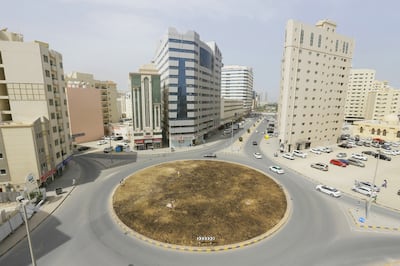
“They basically activated this public art project for the Biennial,” he says. “It’s changed my relationship with these gardeners over time.” Short Circuitsalso features photographs of the roundabout during the project, showing how the land and its crops developed over time.
During the time Divecha spent with the gardeners, he discovered they had a penchant for poetry. The 2021 video artwork, Dohrana, pays homage to this. The project invited the gardeners to develop their own poems, such as ghazals and nazms, which often reflected on their rights and experiences as migrants, as well as hunger. The Urdu poems are recited and subtitled against landscaping sites along intersections – sites similar to where the gardeners work.
“We made a very elaborate film,” Divecha says. “This was a complete shift in my collaboration with them. Initially I was going into their spaces and working with farming and gardening, but now they’ve entered a different creative field. It also renegotiates my relationship with the gardeners.”
Also exhibited is Degenerative Disarrangement, a work originally presented at Al Fahidi Historical District in 2013 before being exhibited at the National Pavilion – UAE for the 2017 Venice Biennale. The work features a brick tessellation, rearranged from its original form and with jumbled road markings. With each iteration of the project, the workers are asked to tile the bricks according to the time limitations they usually face. It is a process that prioritises speed over precision – just like in real-life scenarios.
“This is again about time, value and labour,” he says. “But also this notion about how when a brick is uprooted from its original place, it is sort of misplaced forever.” The bricks, he adds, were sourced from the Al Ghubaiba bus station in Bur Dubai.
“I somehow convinced the Road and Transport Authority to let me have these bricks,” he says. “I really slip into systems out here. I work with the municipality. I work with different kinds of operations out here and try and find myself within that.”

One of the most arresting works at Short Circuits is Road Marking, which makes use of the thermoplastic paint used to delineate lanes. For this project, Divecha collaborated with workers tasked with drawing the road markings in Dubai. The artist presented them with grey rectangular boards, asking them to incorporate the works into their daily workflow. The boards were sometimes introduced in the middle of maintenance work and during rush hour, featuring unswerving lines. Others, meanwhile, came during relatively more idle times, and as workers felt they had more time, they began taking artistic liberties, leaving thick payers of paint in some places, and letting it playfully ooze in others.
Among Divecha’s more recent works is his ongoing Wall House, a project as part of which the artist is aiming to build a museum of hundreds of walls. A proposal of the museum, a blueprint of sorts, is exhibited at Short Circuits.
“It’s a ludicrous project,” Divecha says. “I’m trying to extract walls, complete walls from buildings that have been demolished. These walls tell stories of people. I’ve removed my first wall from Abu Dhabi. I want to create this archive of walls. I’m trying to find people who take me to these walls, I don’t really decide which wall to take. For example, recently I was in Sharjah, and there was a demolition contractor who showed me a boundary wall of a graveyard. They were demolishing it. On the other hand, there is somebody from India who wants to give me a wall from a classroom in Kerala, because somehow he heard about this project. I want to create a ludicrous vision, a museum that challenges ideas of beauty. And these are the bits of walls I’m looking at.”
Courtesy: thenationalnews

